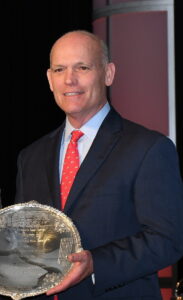Entries for U.S. Equestrian Federation-licensed shows were up 30,000 from 2022 to 2023, and figures for this year through July are on track for another projected increase, according to the federation’s CEO, Bill Moroney.
“Overall, our numbers are right where we wanted them to be at this point,” he said, noting the entries stood at 262,000 as of the end of July.
He was responding to comments made by Andrew Philbrick of Princeton Show Jumping in New Jersey, who canceled his last three shows of the season due to low entries. (Read the story about the cancellations on this link.)
“USEF horse show entries are down nationwide and profoundly down at many East Coast shows,” Philbrick contended as he announced the cancellations. He maintained that show “licensing is not transparent; it’s very hard to understand what the process is. I think we need to take a really hard look at licensing.”
He mentioned mileage exemptions given to shows in his region that are running against Princeton, but some of his shows also have needed and received exemptions because they are within the 125-mile limit of HITS in Saugerties, N.Y., and Old Salem in Westchester County, N.Y.
Moroney noted licensing procedures are spelled out in Chapter Three of the USEF rulebook.
“We follow the rules,” he maintained
Philbrick, a board member of USEF affiliate U.S. Hunter Jumper Association, had served on the USEF competition management committee at one time.
Part of the current situation on which Moroney and Philbrick agree is that competitors’ migration patterns have changed.
Philbrick cited FEI (international) shows in Michigan (Traverse City), Lexington, (Ky.), and Tryon (N.C.). drawing away customers from the Northeast, even though they are not within the mileage limits. He also mentioned “new and relatively new” FEI shows closer to New Jersey at Old Salem; Greenwich, Conn., and Silo Ridge in New York, in addition to HITS. as a factor in who attends his shows.
A change of management and investment that has led to major improvements in arenas and barns at HITS, about a 2-and-one-half hour drive from Princeton’s venue in Montgomery Township, for instance, has led to a slight disruption in the Northeast by drawing exhibitors who previously might have stayed closer to home or gone elsewhere.
The demand for FEI shows has grown exponentially, which also figures into the equation. The number of FEI shows in the U.S. is second only to the number held in France.
Princeton licenses between 18 and 20 national shows a year from April through October, according to USEF.
Riders and owners now are willing to travel further for a show that may have different offerings or atmosphere than where they usually compete.
“Value propositions speak to them,” said Katlynn Wilbers, USEF’s director of competition operations.
“The (customer) experience the trainers and the riders and everybody is getting is way more important now than it’s probably ever been in the past,” said Moroney, mentioning that also applies to the situations in which the grooms are working.
“It’s a lot easier to write a check when you’re getting good value for your money,” he commented.
The stable of Olympic show jumping medalist Chris Kappler usually shows at Princeton, which he praised for good footing, fences and course designers.
“We haven’t been there this year because our shows have taken us further away,” Kappler said, but added about Princeton, “every time I’ve been, I’ve seen them as successful and doing well. So when I learned this (about the cancellations) I was a little bit surprised. The show has always been a very solid regional show.”
Another factor is that exhibitors are tending to change the dates they would normally show; they are willing to compete on weeks other than their usual pattern if it enables them to go to certain venues.
At the same time, people on social media are complaining that the costs of showing mean they can’t compete as often as they once did, or mentioning they prefer to save up for the experience of a special show, rather than going to certain other shows regularly as they once did. The one- and two-day shows in New Jersey that once were staged by boarding or lesson stables have diminished greatly as development has made incursions on the state’s equestrian scene and hurt the lower and middle end of the sport there..
The trend today, which has threatened one-week boutique shows, is toward multi-week shows where people can stay in a place for awhile instead of picking up and moving every week. That takes less effort and saves on horse transportation costs.
There are many more competitors today than there were at the time when USEF licenses were held by shows for three years. Now license renewal is annual, giving USEF an opportunity to judge the impact of exemptions.
Mileage between shows is not set in stone. USEF sees a greater need for diverse offerings to meet competitors’ needs. The mileage exemption process for shows applying for dates, on which the USHJA weighs in, was created to address density or lack of offerings in certain areas. Existing shows can offer input along with the affiliates and the USEF staff.
“People shop differently all the time,” Moroney observed.
In an era of change, he suggested that shows should survey their clients to see what they like and don’t like about a show, as well as what they are looking for when they decide where to compete, so adjustments can be made if necessary.
“If your business is dropping off, you try to find out why it it is,” he said.
“Our job in responsibly managing the calendar is making an effort to insure that our members have the diversity of venues they need and the diversity of offerings to develop their own skills as a rider and also to develop their horses’ skills That means sort of a mix of different levels of competitions,” Moroney explained.


